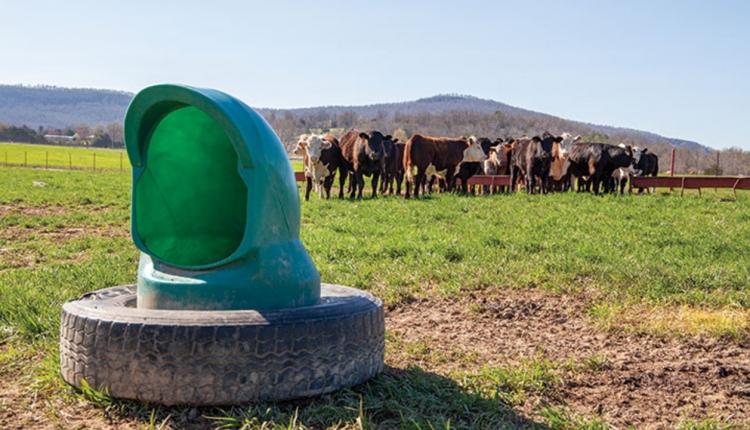Reynolds is an extension beef program specialist with Iowa State University (ISU). Schwab is an extension beef specialist with ISU.

Drought has had a large impact on feed inventories and prices, causing many operations to assess and reduce feed costs.
Although it’s good to keep feed costs in check, extra pressure on the feed bill often results in fewer nutrients fed leading up to calving, during postpartum recovery and as estrous resumes. Further, the breeding season kicks off with rapidly changing spring grass as the forage base coupled with peak nutritional demands as cows lactate to provide for their calves.
To achieve and maintain pregnancy, a cow must have adequate nutrients available. Ideally, you record body condition score at calving and have an understanding on the nutritional plan leading up to and following calving. A female’s body condition score at calving is correlated to multiple production measures, including the likelihood the cow will conceive during the following breeding season.
For females that are under conditioned at calving, providing a positive plane of nutrition and increasing body weight leading into the breeding season is a proven strategy to get more females bred.
Considering the two points above, a supplementation program while cows transition onto spring grass and prepare for the breeding season may be warranted, particularly this year. There are a few basic rules and considerations when deciding on an effective supplementation program.
Evaluate pasture growth and forage availability: Two factors come into play — the amount of available forage and the cows’ ability to consume it. For cows to get adequate intake, forage must be tall enough for the cow to wrap her tongue around, bring it into the mouth, and shear it off with the lower teeth. Unlike sheep and horses, cows cannot nibble on short forages close to the ground. This is one reason we often suggest delaying pasture turnout until the forage is at least 6- to 8-inches tall.
Second, daily intake is limited by the number of bites taken per day. While there is individual variation, most cows will graze for seven to 12 hours per day, taking roughly 30,000 bites of forage. They then ruminate for six to eight hours per day. For shorter forage, cows will take more bites, but there is an upper limit to what the cow will consume on short pastures.
Determine the limiting nutrient: To get the most return out of any feed supplement, you need to identify the limiting nutrient. Early spring pasture is rightfully described as rapidly growing, high-moisture forage. Spring pasture growth is when peak protein content is reached. This is a highly degradable, very digestible protein. That, along with more water in the diet, results in a high passage rate that boosts the rumen microbe population’s energy demand, and ultimately, energy is often the limiting nutrient in early spring pastures, assuming adequate forage availability.
Source and price supplement options: Compare the price of different supplements available based on price per unit of nutrient (energy or protein). First, identify supplement options that can be sourced, stored, and fed in your operation. Next, take the total delivered cost per pound of a supplement and adjust based on the dry matter content and then the nutrient content using the base diet’s limiting nutrient. For early spring pasture, this is typically energy, most commonly measured as total digestible nutrients (TDN).
While the least cost per unit of supplement is important, also consider ease of storage and feeding, access to the feedstuff, and handling benefits when selecting supplements.
Evaluate the type of supplement and expected response: One thing to remember when supplementing energy is that not all feedstuffs act and digest in the rumen the same. The type of feed and amount fed need to be considered. When fed at greater than 1% of body weight, some forage intake can be displaced, but the response will be more apparent with a grain-based supplement rather than a digestible fiber such as soybean hulls and gluten feed. Starch-based supplements are best fed daily due to how they act in the rumen. A benefit of fiber-based supplements is the option to supplement every other day.
Provide adequate mineral supplementation: Minerals are required for immune status, reproduction, and growth, so provide adequate minerals based on the forage available. High-magnesium minerals are important for early spring pastures to reduce the risk of grass tetany, and blended or chelated minerals are beneficial during the prebreeding period.
Consider adding an ionophore. Data shows that including an ionophore will reduce the postpartum interval by an average of 18 days. By shortening the postpartum interval, females cycle earlier and are more likely to breed. Additionally, when bred earlier in the season, the resulting calf will be older, heavier, and more valuable at weaning. Monensin is the only approved ionophore for breeding stock, and there is no free-choice label, meaning it has to be delivered through a daily ration or supplement.
Nutrition of the cow from calving through breeding season is critical for both the health of the cow, milk available for the growing calf, and the ability to rebreed. Don’t simply turn cows out on spring pasture and hope for the best. Planning now will benefit the long-term success of your cow herd.
This article appeared in the April/May 2022 issue of Hay & Forage Grower on page 31.
Not a subscriber? Click to get the print magazine.

